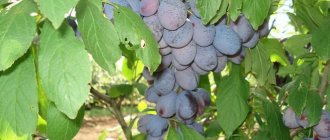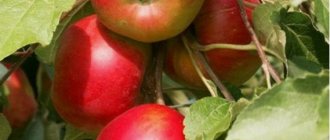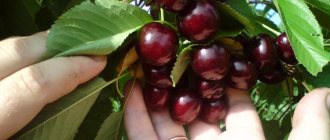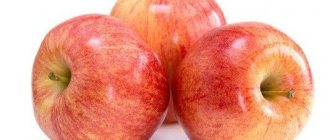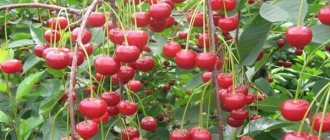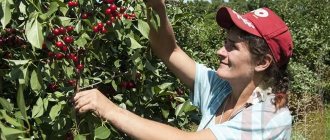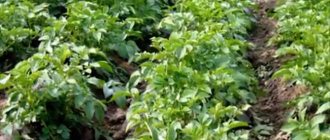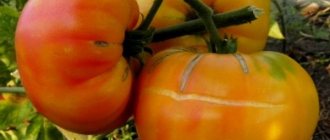History of variety selection
The plum is considered a cultivated species that has existed for several millennia. It appeared in Russia back in the 17th century. And towards the end of the 18th they began to use it almost everywhere. Each land owner could plant the variety for commercial purposes. The Anna Shpet plum grows beautifully in central Russia, but has received greater recognition in the Crimea, Ukraine and Moldova.
The plum variety Anna Späth was bred at the end of 1870 by the German breeder Ludwig Späth. He practiced his activity on crossing lilacs, and a plum tree randomly grew next to it. Anna Shpet plum seedlings are considered free pollinating. In the USSR in the mid-1940s, the Anna Shpet variety became widespread, and only later they became interested in it in the Rostov region and Krasnodar region. By the end of the last century, plums were grown “among our neighbors” in Belarus.
Harvest and storage
The variety begins to bear fruit in the fourth or fifth year of life. It is late, so you can get ripe fruits only by the end of September. Harvesting is carried out manually in several stages.
The commercial freshness of the fruits is not lost within 10 days if they are stored in the refrigerator. For longer storage, you need to preserve them. Freezing and drying such plums is not recommended, as its taste deteriorates.
Although the Anna Shpet variety was developed a long time ago, it has not lost popularity to this day due to its high yield, excellent taste of fruits and low maintenance requirements. By observing the minimum requirements when growing a plant, you can achieve a yield of 100 kg from one ten-year-old tree.
Description of the plum variety Anna Shpet
Anna Shpet's trunk is very tall and has a dense pyramidal crown. The bark is grayish in color. The shoots are thickened and dark. They have brown internodes. The variety bears fruit until old age. The buds on it are pointed towards the top, the tips are thin. Color: light green. The structure is matte, sometimes there are jagged edges on the edges. There are no stipules, the petioles are shortened.
The flowers are large, light, and grow in pairs at once. The peduncle is medium in size, and the plum petals are oval in shape with beautiful wavy edges. Stamens are abundant, anthers are yellow. The fruits themselves of the Anna Shpet plum variety are very massive, up to 50 g. They have a dark purple coloring, sometimes with burgundy barrels. Oval in shape, do not have pubescence, like other varieties. The skin is not thick, but not transparent, it is easily separated from the plum pulp, and is sometimes covered with a coating of wax. The seeds are grayish in color.
The pulp of the Anna Shpet plum is sweet, dessert-like, and yellow-green in color. The consistency is dense, but not hard. The juicy interior becomes tart when fully ripe, and the seed grows small. It is easy to separate it from a ripe plum. This is a heat-loving tree that is best planted in sunny cities and countries. Southern regions have more advantages for its growth and fruiting.
Crown formation
Plum "Anna Shpet" (the description of this variety was given above in detail) is a tree, among other things, that requires periodic pruning. It is advisable to remove unnecessary branches from plants of this variety at least three times per season. This is done for the first time in the spring, shortening last year’s growth and cutting off excess shoots that thicken the crown too much. The second pruning is carried out in the summer - in July. This time, all branches that did not survive the winter well are removed. In summer they are clearly visible due to the weak foliage. Also at this time, you need to remove all branches affected by pests from the tree and, of course, remove the shoots. In the fall, light rejuvenating pruning of the plum tree is done. At the same time, the top is shortened and all damaged and broken branches are removed.
Characteristics of the variety
Anna Shpet plum is a late variety of fruit seedling, where the fruits ripen only in mid-autumn. They do not fall or rot, and can remain on the drain for a long time even until full ripening, despite the cold weather. The following advantages of this variety are highlighted:
- The high fertility of the Anna Shpet plum - the fruits can be stored for a long time, and the tree, thanks to self-pollination, can bear fruit every year.
- Large and tasty plum fruits. Small plums usually spoil immediately after ripening.
- Early fruiting of Anna Shpet - still half-ripe plums can be collected for preservation.
- Late ripening of the Anna Shpet variety.
- Unpretentiousness in caring for the plum variety Anna Shpet.
- Possibility of storing fruit in preparations for more than 2-3 years.
- Increased degree of regeneration of plum Anna Shpet.
Such characteristics make it possible to harvest large, sweet fruits even from an adult 20-year-old plum tree. One harvest produces about 130-140 kg of plums. Anna Shpet will bear fruit 4-5 years after planting for several decades.
Drought resistance, frost resistance
This plum variety is not very resistant to frosty weather, but even during frost it can recover on its own. It is still not suitable for growing in cold regions, since Anna Shpet is a heat-loving plant. There will be a harvest, but it will be small and not rich. In the southern region, the plum will hurt less, although it does not have any special requirements for soil and care. But drought is not a problem for Anna Shpet; she tolerates it well and produces an abundance of fruit.
Plum pollinators
The Anna Shpet plum is self-fertile, but it needs cross-pollination for rich fruiting, otherwise you can count on a meager harvest. Plums are considered the best pollinators:
- Victoria;
- Catherine;
- Renklod Altana;
- Renklod green.
The Shpet plum bears fruit every year and very abundantly. But even she needs to be provided with good care in order to collect tasty fruits.
Productivity and fruiting
The stability of the yield of the Anna Shpet variety is achieved through agricultural technology, and if an adult tree has once produced a rich harvest, it will always produce a minimum of 100 kg of ripe fruit. Plum bears fruit, starting from 5 to 15 years, 60-80 kg, and an adult one is twice as much.
Area of application of berries
Anna Shpet plum berries are often exported, and thanks to the characteristics of the variety, they can not lose their taste for a long time. Farmers do not process the fruits; they only place them in commercial refrigeration chambers to preserve their appearance and taste. It is good to make various twists and compotes from them, and in cosmetology oils of pits and plum seeds are used.
Resistance to diseases and pests
Anna Shpet is not very resistant to moniliosis and polystigmosis. The latter is a disease expressed by spotting on plum leaves. Infestation can be noticed at the beginning of the summer season after heavy rainfalls. Yellow spots cover the leaves and then rot, forming reddish spots.
Important! If you don’t cure Anna Shpet when the leaves have already turned orange, you can forget about the yield. The leaves will fall, the tree will weaken, and frost resistance will decrease.
To protect the fruits of the Anna Shpet variety, you need to treat the bark with Bordeaux mixture or substances with fungicides. After harvesting, before severe frosts, the leaves are sprayed with copper sulfate, as is the soil around Anna Shpet. Fallen leaves will serve as a breeding ground for pests, so timely collection is mandatory.
Moniliosis affects not only the leaves of the plum variety. The shoots become reddish and dry out quickly. Anna Shpet's berries have a pronounced gray growth, which is why they rot. The fight against this disease is the same as in the case of the previous one, only all diseased branches and infected shoots must be treated.
Rodents also like to feast on fruit tree trunks, so the plum tree is covered with thick fabric or polymer mesh. Hares and mice will also not be able to get close to the trunks, and frost will not damage this variety as much.
Advantages and disadvantages of the variety
The characteristics of the Anna Shpet variety indicate that the fruits of this variety are very sweet and juicy, like a summer dessert. This is an incomparable advantage, because few fruit trees can “boast” of fruits of such quality. A rich harvest and the ability to withstand winter are a big plus for many farmers. The only disadvantages include diseases and attractiveness to small pests.
Advantages and disadvantages of the variety
Many people prefer this particular variety, because the tree has a lot of positive qualities and advantages. The main advantages are:
- no special effort is required in care and cultivation;
- the harvested crop can be stored for quite a long time without losing its appearance and taste;
- the tree produces a large harvest;
- fruit ripening later;
- the tree easily and quickly recovers after suffering drought or severe frost;
- the fruits have excellent taste;
- the variety has high frost resistance, so you don’t have to cover the tree before winter.
Despite the many advantages, this plum variety also has some disadvantages. The main disadvantages are:
- the fruits may crack if the harvest is not harvested on time;
- the wood is very loose;
- During harvesting, certain difficulties may arise.
Landing Features
The plum variety Anna Shpet loves warmth, so the soil should be open. The soil needs treatment, since the end of the winter season means warming and the appearance of diseases.
Recommended timing
The optimal period for planting seedlings is considered to be autumn and spring - it is best to do this in April, when the soil has not yet warmed up, but is no longer frozen. Plum loves the south side, so planting material must be protected from possible gusts of wind. Drafts should also be excluded, and trees should not be planted along the walls of houses or garages. This blocks the flow of sunlight.
Choosing a suitable location
The soil for growing the Anna Shpet variety is good almost everywhere in mid-latitudes. The main thing is fertile, loose soil, which should not have very high acidity. Does not tolerate stagnant groundwater drainage. Trees of this variety should be planted at the lowest point of the landscape, where the groundwater level is above 2 meters.
What crops can and cannot be planted nearby?
To get a richer harvest, you can plant Hungarian or Catherine. Since the home plum Anna Shpet is partially self-fertile, it is recommended to plant Izyum-Erik. Altana will improve the taste, and the Crimean variety will add “blueness” to the fruit.
Selection and preparation of planting material
Seedlings should have a clear central part of the branch, from which two or three lateral branches extend. What you should pay attention to:
- There should be no noticeable defects on the rootstock and scion. The exposed roots can be easily felt and are ripe.
- The trunk should have a smooth bark surface. This is the main condition, otherwise the tree will not take root or will fall on its side.
Advice! It is best to buy a two-year-old seedling of a zoned plum.
Landing algorithm
The planting pit is prepared in the fall. If the event is held in the spring, you need to fertilize the soil three weeks before planting Anna Shpet's seedlings. In autumn, the ground is fertilized with 100 grams of potassium magnesia or clean manure. Take 7.5 kg per 1 m2. To reduce the acidity level, sprinkle the soil with dolomite flour or lime:
- For one pit, 9 kg of compost is taken.
- 160 g wood ash.
- 1 bucket of sand.
The yield and growth rate of the seedling will depend on how nutritious the composition is. The hole is dug with parameters of 0.5 in depth and 0.7 in width. Plum roots are dipped into clay. Egg shells are placed at the bottom of the hole.
Next, the bottom is covered with humus. Then add clean soil and superphosphate - 500 g. A peg is placed in the center. The neck of the Anna Shpet seedling should be 5 cm above the soil level. Around the hole should hold 25 liters of water.
Then everything is covered with sawdust and dry soil. More details about the algorithm in the video
Important! Planting plums should be done in calm weather, when there are no drafts, preferably sunny.
Important nuances regarding tree planting and preparatory procedures
The Anna Shpet plum is thermophilic, so an area for it is selected that is open and well-warmed by the sun. But at the same time, a barrier should be located nearby to protect the tree from sharp gusts of wind and cold drafts. After all, it can easily break. The best option is to plant a tree on the south side, near a fence or house.
Most gardeners plant this plum in the fall, in the first half of September. But nothing prevents spring planting. In regions with the most suitable climate for the crop, there is no need to fear that the seedling will be subject to sudden return frosts or winter will suddenly come.
Anna Shpet is unpretentious when it comes to soil quality. She has only three requirements - the soil must be loose and have a neutral acid-base balance. The “poorness” of the substrate can be easily leveled out by regular application of suitable fertilizers, and the “heaviness” - with coarse river sand. Dolomite flour, slaked lime, and ground eggshells cope with excess acidity. The last prerequisite is groundwater located deep below the soil surface. If they come closer than two meters to it, give up the idea of placing the plum in that particular place. If there is no alternative, a hill of at least 70 cm in height will have to be built.
Dolomite flour is a natural soil deoxidizer; if you do not exceed the recommended dosage, it is absolutely safe for people and plants
High-quality planting material is the key to a bountiful harvest in the future. Therefore, purchase seedlings only from trusted suppliers. Two-year-old plums bought in the same area where the garden plot is located take root best.
When choosing planting material, be very careful and picky - this applies to any garden crops
The root system of the plant is developed, so the planting hole is dug to a depth of 65–70 cm. From this moment, at least three weeks should pass before Anna Shpet is planted in the ground. A layer of drainage is required at the bottom so that water does not stagnate at the roots. Fertilizers are added to the pit - 10 kg of humus or rotted manure, 100 g of potassium sulfate and 140 g of simple superphosphate. Plum also reacts well to natural fertilizers. A natural source of potassium and phosphorus is wood ash (about 3 liters is enough). Be sure to stick a peg into the bottom of the hole to secure the seedling. If you do this after the plum has already been planted, you can injure the roots.
Drainage at the bottom of the planting pit for plum Anna Shpet is required - this can be expanded clay, brick chips, small clay shards, crushed stone, and so on
They begin to prepare the tree for planting about a day before the procedure. The roots are soaked for 6–8 hours in a solution of any biostimulant, adding a few crystals of potassium permanganate for disinfection. They are then coated with a mixture of fresh cow dung and powdered clay. The mass should dry, this will take 4-5 hours if you leave the plant in the sun.
Epin is one of the most popular biostimulants; Such drugs improve the plant’s immunity and facilitate its adaptation to a new environment after transplantation to a permanent place
Anna Shpet is planted by forming a small mound at the bottom of the planting hole. The main thing is not to deepen the root collar in the process. When the hole is completely filled, it should be 5–7 cm above ground level. The seedling is watered, using 25–30 liters of water, and the soil is mulched.
For planting, choose a warm, sunny, windless day. When planting an entire garden, about 2–2.5 m are left between neighboring trees, and the row spacing is 3 m.
Video: procedure for planting a plum seedling in the ground
Aftercare for plums
After planting, plums need to be processed. Care consists of following agricultural techniques. The variety's culture, although unpretentious, still requires mineral fertilizer. Activities need to be carried out systematically. You need to water the plum 3 times:
- when the shoots began;
- when did the fruits appear?
- after the plum harvest.
The average figure is 40-45 liters per plum of this variety, but the total amount depends on the age of the Anna Shpet plum. The earth is moistened for better work with it, the soil becomes pliable at the level of 20-30 cm, but you should be careful with water - the tree does not like either drought or excessive flooding.
Pruning is carried out immediately after planting the Anna seedling. The branches are cut by a third in the first 4 years, then by a quarter. When forming the crown, a sparse-tiered technique is used. After each time, treatment with garden varnish is necessary.
Feeding is carried out by month:
| Season | View | Period | Fertilizers and proportions |
| Spring | Root | Before flowering | Prepare a solution of urea and potassium sulfate 1:1 with the addition of 30 liters of water for one tree |
| During flowering | A mineral type solution is prepared with the addition of urea and water in a ratio of 2:1. They need to water the plum - 4 liters for each seedling | ||
| After | A solution of mullein and water 3:1. Approximately 40 g of superphosphate per tree | ||
| Summer | Foliar | The beginning of June | 3% urea solution - spray the tree |
| Autumn | Root | Mid - end of September | Potassium chloride and superphosphate 2:3 per 10 liters of water. Water 30 liters per tree |
| Here you need lime, which will moisten the soil - disinfection is carried out by introducing a solution of chalk and ash. Once every 5 years as necessary | |||
| Before digging, sprinkle with manure or compost (15 kg) with the addition of ammonium nitrate - 50 g |
For wintering, trees need to be covered with synthetic material and the trunks whitened. A nylon mesh is also used if there are rodents. So Anna Shpet will be a pleasure to grow plums and will not cause any trouble.
Diseases and pests, methods of control and prevention
If you properly care for the Anna Shpet variety, rodents and pests will not be scary. However, to combat them it is still worth stocking up on some means:
- A carbamide solution is used against the plum moth.
- You can get rid of the sawfly by using Karbofos or Cyanox.
- "Nitrafen" and "Metaphos" are used against fruit red mites.
Important! Harvesting the leaves of the plum variety Anna Shpet is a preventive measure, and to prevent pests from multiplying and spoiling the plum, you need to constantly whitewash the crown and trunks with branches.
